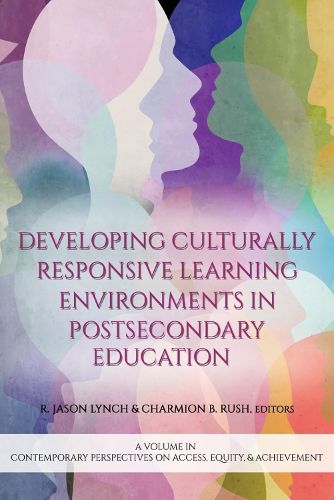Readings Newsletter
Become a Readings Member to make your shopping experience even easier.
Sign in or sign up for free!
You’re not far away from qualifying for FREE standard shipping within Australia
You’ve qualified for FREE standard shipping within Australia
The cart is loading…






This title is printed to order. This book may have been self-published. If so, we cannot guarantee the quality of the content. In the main most books will have gone through the editing process however some may not. We therefore suggest that you be aware of this before ordering this book. If in doubt check either the author or publisher’s details as we are unable to accept any returns unless they are faulty. Please contact us if you have any questions.
U.S. colleges and universities are rapidly diversifying. In 2018, the U.S. Census Bureau estimated that nearly half of undergraduate students were of non-white racial identities, with that number only increasing for future generations. This increase in diversity holds true for many other identity groups. Yet, faculty demographics remain disproportionately white and male. For years, students have called for institutions of postsecondary education to support their success through adopting more culturally relevant practices for teaching and learning. Scholarship on student success in college has also echoed this call. Developing Culturally Responsive Learning Environments in Postsecondary Education was developed to help postsecondary educators answer this call through a multilayered view of student support within the college classroom and beyond.
Specifically, this book features twenty-three chapters divided into four parts. Each part corresponds with four thematic areas identified as an important component in developing culturally responsive learning environments: unpacking educator cultural competence; learning experiences of the 21st century college student; culturally responsive teaching and instruction; and transforming curriculum, content, and environments. Authors representing diverse backgrounds and institutional contexts come together to offer their own scholarly and practical expertise to tackle issues ranging from combating implicit bias and building cultural competence to exploring specific student experiences and practical ways to implement culturally responsive pedagogies. In addition to each chapter, this volume provides a companion case scenario exercise for you to directly apply the content from the book. Ultimately, we hope this book provides you with a meaningful starting place to help you honor the diversity of your students and support their success within your learning context.
$9.00 standard shipping within Australia
FREE standard shipping within Australia for orders over $100.00
Express & International shipping calculated at checkout
This title is printed to order. This book may have been self-published. If so, we cannot guarantee the quality of the content. In the main most books will have gone through the editing process however some may not. We therefore suggest that you be aware of this before ordering this book. If in doubt check either the author or publisher’s details as we are unable to accept any returns unless they are faulty. Please contact us if you have any questions.
U.S. colleges and universities are rapidly diversifying. In 2018, the U.S. Census Bureau estimated that nearly half of undergraduate students were of non-white racial identities, with that number only increasing for future generations. This increase in diversity holds true for many other identity groups. Yet, faculty demographics remain disproportionately white and male. For years, students have called for institutions of postsecondary education to support their success through adopting more culturally relevant practices for teaching and learning. Scholarship on student success in college has also echoed this call. Developing Culturally Responsive Learning Environments in Postsecondary Education was developed to help postsecondary educators answer this call through a multilayered view of student support within the college classroom and beyond.
Specifically, this book features twenty-three chapters divided into four parts. Each part corresponds with four thematic areas identified as an important component in developing culturally responsive learning environments: unpacking educator cultural competence; learning experiences of the 21st century college student; culturally responsive teaching and instruction; and transforming curriculum, content, and environments. Authors representing diverse backgrounds and institutional contexts come together to offer their own scholarly and practical expertise to tackle issues ranging from combating implicit bias and building cultural competence to exploring specific student experiences and practical ways to implement culturally responsive pedagogies. In addition to each chapter, this volume provides a companion case scenario exercise for you to directly apply the content from the book. Ultimately, we hope this book provides you with a meaningful starting place to help you honor the diversity of your students and support their success within your learning context.